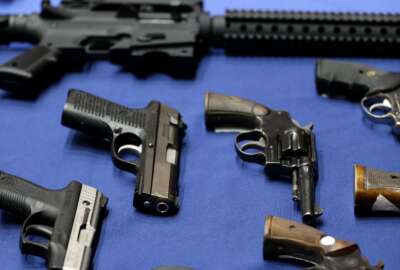Agencies don’t always know where their firearms are. Federal law enforcement agencies — including components of the Homeland Security Department, the Bureau of Land Management and the Federal Bureau of Prisons — lose a multitude of guns, bullets and other munitions every year due to faulty inventory tracking systems and theft.
The House Oversight and Government Reform Committee is investigating the severity of the problem and whether any progress has been made after the Justice Department Office of the Inspector General exposed these issues in multiple reports dating back to 2003.
“Gentlemen, you’re here because of your systems being deplorable. There’s no other word to describe them,” said Rep. Mark Meadows (R-N.C.).
DoJ IG Michael Horowitz said that after the most recent audit, the Bureau of Prisons has implemented three of the 14 recommendations listed in the report, which is roughly the amount of progress he expected.
Thomas Kane, acting director of the bureau, said that a new inventory control system would be in place in early winter of 2017, and that updates on the system would be available in the spring.
The bureau’s current system has no way to track its inventory of “expendables,” meaning bullets, chemical agents and other munitions meant to be used up. In 2011, a guard at a supermax prison in Colorado was caught and pleaded guilty to stealing “flash-bang” grenades from the prison armory.
“They weren’t keeping control and understanding what they were using versus what might have been stolen,” Horowitz said.
Another major issue with the inventory systems is how inventory was being coded. Meadows said that bureau had coded $67,000 worth of inmate clothing and $15,000 of feminine hygiene products as body armor, and $113,000 of food coded as chemical weapons and equipment. Meanwhile, DHS had a firearm procurement code “for the cable dude.”
“If you can’t code it right, the best new system in the world isn’t going to fix the problem,” Meadows said. “So what we need is real accountability, real coding, and a real inventory system that, honestly, you could probably put on Quickbooks today and do better than what we’re doing.”
DHS and BLM have another problem: theft.
Jeff Orner, DHS’ chief readiness support officer, said they lose on average 69 firearms per year, and that 75 percent of those are to theft. In 2015, it reported 72 lost firearms, although 16 of those were recovered.
DHS has made moves to improve how it secures its firearms to prevent theft. Orner said that about two years ago, someone stole a weapon out of a vehicle belonging to Immigration and Customs Enforcement. This incident led DHS to realize that most of the guns it was losing were stolen from vehicles.
To combat this, it installed gun lockers in all official vehicles and mandated that if a gun was in a vehicle without the officer, it had to be in the locker, and the car had to be locked as well.
Orner said that this incident and every other has been investigated, although they don’t always result in disciplinary action.
“The actions taken as a result of those losses depend on the nature of the incident,” Orner said. “Somebody who does not follow procedures and leaves a weapon on the seat of a car, that would mandate a disciplinary action. On the other hand, if you have for example a Coast Guard officer doing a boarding who is jostled and loses the weapon overboard, that’s an entirely different type of situation, although it’s still a lost weapon.”
Meanwhile, the Bureau of Land Management has lost eight firearms since 2005. One was lost in the mail, while the other seven were stolen. Six were recovered. One was used in a shooting in San Francisco in 2015. That particular handgun had been stolen out of a personal vehicle four days previous.
BLM currently has 1,480 firearms, 1,048 of which have been issued to officers. The rest are used for training and ceremonial purposes, or are inoperable. BLM issues four weapons to each of its officers: a primary semi-automatic handgun, a backup semi-automatic handgun, a shotgun and a semi-automatic rifle.
“We have got to know where these ammunition and weapons are going,” Rep. Jode Hice (R-Ga.) said. “We have got to get to the bottom of this. Americans should never fear the irresponsibility of our government agents who are incapable of keeping properly a weapon issued by our government.”
Copyright
© 2024 Federal News Network. All rights reserved. This website is not intended for users located within the European Economic Area.
